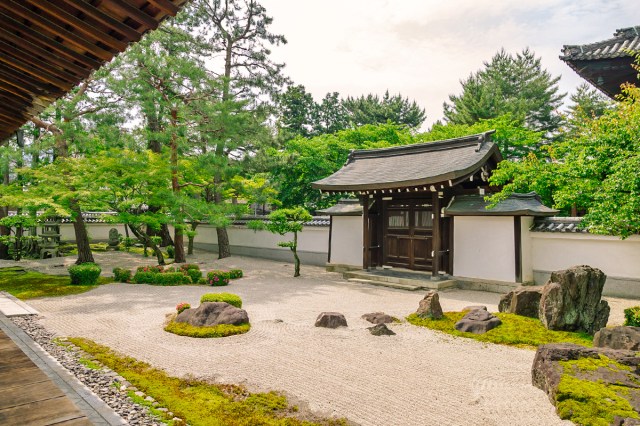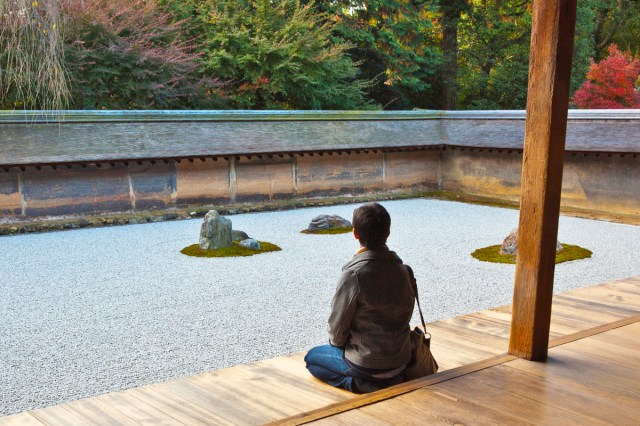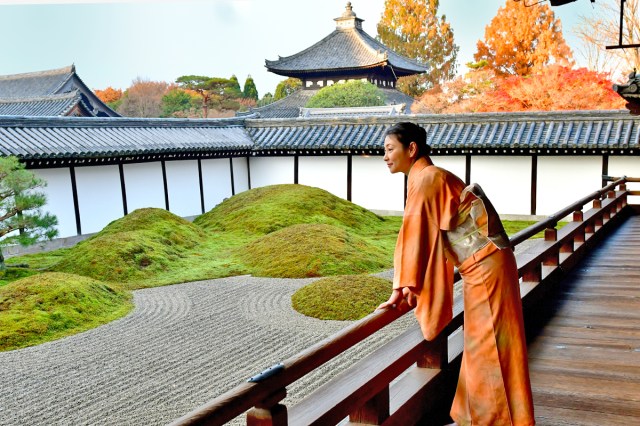
A Minimalist Landscape
Japanese Zen gardens — which are only so called outside Japan; in Japan they’re known as karesansui, or “dry landscapes” — date back about a thousand years. Early Zen gardens were inspired by the rock gardens of China’s Song Dynasty, wherein stones were placed to mimic mythological mountains, while sand or gravel were meant to evoke water features.
After Zen Buddhism was introduced to Japan around the 12th century, Buddhist temples began incorporating elements from karesansui into their designs. By the 14th century, dry landscape gardens had become a defining feature of temple grounds in Japan.
Unlike the country’s lush pond gardens or foliage-filled tea gardens, Zen gardens strip the landscape down to its fundamentals: gravel, rocks, and occasionally sparse plantings. The gravel is carefully raked into patterns that mimic rippling water, while stones suggest islands or mountains. The purposefully simplified structure gives the mind room to wander and imagine, focusing on the subtle details rather than chaos around you.

Inviting Meditation
These gardens aren’t just about aesthetics. Zen Buddhism emphasizes mindfulness, simplicity, and impermanence, with meditation at its core. Zen gardens were designed to embody those principles and to invite a meditative state.
Empty spaces or raked indentations represent the Buddhist notion of emptiness, the view that things have no fixed nature and exist only in relation to one another. Carefully placed rocks reflect the Buddhist idea that while things may appear solid, they are ultimately fleeting, helping visitors reflect on life’s impermanence without clinging to things. Meanwhile, flowing lines in the sand conjure mental images of water and the movement of the natural world.
The act of raking itself is also a form of movement-based meditation, cultivating patience and awareness of the present moment. Some of the most famous gardens, such as Kyoto’s Ryōan-ji, with its 15 carefully placed stones, or Kennin-ji’s subtemple Seirai-in and its white sand depicting drifting clouds, demonstrate those principles through minimalism, asymmetry, and abstraction, creating spaces that encourage reflection without distraction. Zen gardens are a living lesson in simplicity and presence.

The Science of Calm
Zen gardens aren’t just spiritually soothing — they also have real effects on the mind and body. Environmental psychology studies have shown that being in and observing nature can reduce stress, lower blood pressure, and improve focus.
The minimalism of Zen gardens also contributes to their calming effect. Architect and Zen garden expert Mira Locher explains that the Japanese concept of yohaku no bi, or the beauty of blankness, is a defining aspect of the Zen garden. Uncluttered visuals help quiet the mind and foster meditation.
Those wide-open, minimal spaces give the eye and mind room to rest. Observing asymmetry can help us slow down and notice subtle details. The smooth, flowing lines in raked gravel, meanwhile, echo the visual complexity of natural patterns, which the brain interprets as harmonious, helping reduce stress.
More Interesting Reads

Mini Zen Gardens, Major Relaxation
Most of us, of course, don’t have a sprawling temple courtyard at home. But Zen gardens can be created and benefitted from even in small spaces. Even tiny desktop Zen gardens offer a similar sense of calm.
Raking sand or arranging stones with your hands can provide a soothing tactile sensory experience. It’s a small-scale reminder that slowing down, even for a few minutes, can reset the mind, improve focus, and help reduce the endless noise and mental clutter of modern life.












